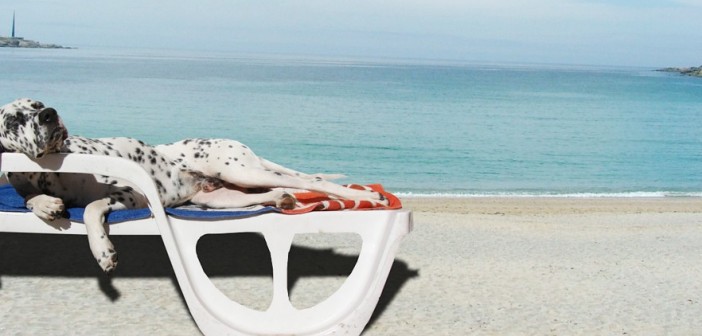Now that the weather is warming up, it’s time for us to be more aware of how the heat affects our furry canines.
 Dog fur is great protection against the cold but can be a problem in hot weather. Dogs have a higher normal body temperature than people, and they don’t cool down as efficiently as we do. Your canine companion is designed more for insulation from the cold than for cooling down. Dogs eliminate heat by panting and also by small sweat glands on the pads of their feet. If the surrounding air is not considerably cooler than the animal’s body temperature – as in the case of a hot, stuffy automobile – their cooling system will not work, their body temperature rises, and heatstroke can occur. This can be fatal if not corrected quickly.
Dog fur is great protection against the cold but can be a problem in hot weather. Dogs have a higher normal body temperature than people, and they don’t cool down as efficiently as we do. Your canine companion is designed more for insulation from the cold than for cooling down. Dogs eliminate heat by panting and also by small sweat glands on the pads of their feet. If the surrounding air is not considerably cooler than the animal’s body temperature – as in the case of a hot, stuffy automobile – their cooling system will not work, their body temperature rises, and heatstroke can occur. This can be fatal if not corrected quickly.
It is important to be aware of the ambient temperature and to avoid placing your dog in an environment where heat stroke can occur.
Causes
On a sunny day with temperatures at or above 70 degrees Fahrenheit, most people know that the temperature inside their car can soar to intolerable levels for their dog. But even outdoors in direct sun, the heat can quickly get to your furry companion and create a health risk.
Some dogs have a greater risk to heat stroke, and you will need to be extra careful about preventing heat-related illness. Some examples of increased risk factors are:
- Dogs with flat faces and short noses, also known as brachycephalic breeds, like Pugs, Boston Terriers, Pekinese, Boxers, Bulldogs, Shih Tzus, don’t pant as efficiently as breeds with longer noses
- Older dogs
- Puppies
- Sick dogs and those with chronic health conditions, like heart disease
- Dogs not acclimated to warm weather
- Dogs that are over-exercised or allowed to overexert themselves in the heat
- Dogs without access to fresh, clean water
Immediate Care
It is essential to remove the dog from the hot environment immediately – either into the shade or preferably inside with air conditioning. Access his condition and take immediate action:
- Is he able to stand? Is he conscious and panting? If so, offer him small amounts of water to drink and take his rectal temperature, if possible.
- If his temperature is at 104 degrees Fahrenheit or lower, remain with him in a cool environment, watch him carefully and keep offering small drinks of water. A large volume of water all at once might cause him to vomit, which will add to the risk of dehydration.
- If your pet is unable to stand on his own, is unresponsive to your voice, touch or the sight of you, or is having seizures, check for breathing and a heartbeat.
- Begin cooling procedures by soaking his body with cool water – cool, but not cold. Use a hose, wet towels, or any other source of cool water that is handy. Take his temperature, if possible.
- Concentrate the cooling water on his head, neck, and in the areas underneath his front and back legs. Carefully cool his tongue if possible, but don’t let water run into his throat as it could get into his lungs. Never put water in a dog’s mouth that can’t swallow on its own. Put a fan on his if possible – it will speed up the cooling process.
- Get immediate veterinary attention. Heatstroke can cause unseen problems, such as swelling of the brain, kidney failure, and abnormal, internal clotting of blood. On the way to the veterinarian, travel with the windows open and the air conditioner on.
- Alert the clinic you’re on the way, so they can prepare for your arrival.
Veterinary Care
Treatment will consist mostly of replacing lost fluids and minerals. This may extend to secondary conditions, which your vet will be able to identify. Intravenous fluid therapy and monitoring for secondary complications such as kidney failure, development of neurologic symptoms, abnormal clotting, changes in blood pressure, and electrolytes abnormalities are typically recommended in cases of heatstroke.
Prevention
Make sure your dog has plenty of fresh, clean water available at all times. If he’ll be outside on warm days for any length of time, he should have access to complete shade.
Give your dog a shorter summer ‘do. A long coat can be shaved to a one-inch length to help him weather the hot temperatures. Don’t go any shorter than an inch, though, because his fur protects him from the sun. If you don’t want to cut your dog’s coat, regular brushing, bathing and grooming will help prevent problems caused by excessive heat.
Exercise your pup early in the morning or after the sun goes down, during the coolest parts of the day. Stay in the shade if possible, and, if it’s 90 degrees or hotter, keep your dog indoors.
Play in the sprinkler with your dog or hose him down with cool water if he must stay outside and can’t avoid temperatures over 90 degrees.
Don’t overdo exercise or play sessions, regardless of the time of day. Over exertion in hot weather – even after dark – can bring on heat-related health problems.
Don’t allow your dog on the hot pavement – it can burn his paws and the heat rising from the concrete or asphalt can quickly overheat your low-to-the-ground pet.
And, of course, never leave your dog alone in a parked car on a warm day. Leave him where he’s cool, hydrated, and eagerly awaiting your return.
If you have any concern that your canine companion might have heat stroke, do not hesitate to immediately contact your veterinarian.
Dr. McCarron is the owner of University Veterinary Hospital & Diagnostic Center in Salt Lake City. She is board certified, specializing in canine and feline practice, and a member of the American Association of Feline Practitioners. Dr. McCarron has enjoyed serving Wasatch Front pets for more than twenty years.




